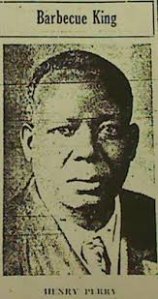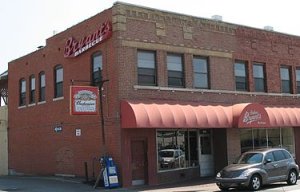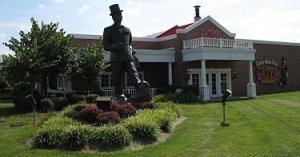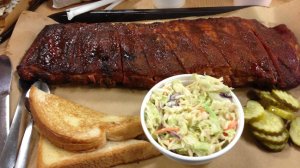KANSAS CITY, Mo. — Several regions throughout the United States have fanatics devoted to their local brand of barbecue, and Missouri is no exception. Kansas City is the birthplace of dry-rubbed barbecue drizzled in tomato-molasses sauce. Kansas City is also known for adding the sticky, finger-licking condiment onto a range of meats, veggies, and fruits.
Origins of barbecuing in Kansas City
Globally, people know Kansas City for its barbecue. Jazz, the Chiefs, the Royals, fountains, speakeasies, and President Harry S. Truman also top the list for what puts the metro in the international limelight. Even still, barbecue is often the first item tourists ask about when they hear about our city.
Smack-dab in the center of the first edition of The Kansas City Star (then called The Kansas City Evening Star), published on Sept. 18, 1880, appeared a story with the prophetic headline “The Grand Barbecue.”
On that day, Kansas Citians held a parade following the completion of a long-delayed railroad connection. The parade ended with an old fashioned barbecue attended by more than 3,000 hungry locals.
On July 3, 1869, Kansas Citians celebrated the historic opening of the Hannibal Bridge — the first permanent railroad bridge to cross the Missouri River. It also followed with a celebration parade and a large barbecue party. Before widespread modernization and cooking gadgets became mainstream, barbecuing food was one of the easiest ways to feed a large group of people.
It’s not surprising that barbecue took off in late 19th century Kansas City. Meat was relatively cheap and plentiful thanks to the city’s stockyards. After the Civil War, many freed slaves left the deep south for new destinations: Kansas City was often picked as a new home for its thriving river and rail hub and dominate meatpacking industry. These jobs promised a new life. The new residents brought with them their culinary traditions, and the city’s love of barbecue created a demand bound for profit.
Barbecuing in the modern times
Henry Perry is considered the Barbecue King and credited with starting and spreading the Kansas City barbecue trend on a wide-scale. Today the Kansas City metro has more than 100 barbecue dining options with a variety of sauces and dishes.
Kansas City-style barbecue makes use of different types of meat including: pulled pork, pork ribs, burnt ends, smoked sausage, beef brisket, beef ribs, smoked or grilled chicken, smoked turkey, lamb ribs, and sometimes fish. Occasionally, Kansas City-style barbecue includes vegetables or fruits.
The barbecue is often rubbed with spices, slow-smoked over a variety of woods and served with a thick tomato-based sauce. There are several different takes on the sauce, but the staple flavor people are familiar with blends both sweet and spicy.
Burnt ends are the crusty, fatty, and flavorful pieces of meat cut from the ends of a smoked beef or pork brisket — these are popular in several different restaurants in Kansas City from Q39, Char Bar, and sometimes Chicken N Pickle. Burnt ends used to be seen as the throwaway part of a brisket, but not anymore. It’s now a shining star of Kansas City-style barbecue.
Staple side dishes include: baked beans, fries, coleslaw, potato salad, cornbread, and vegetables.
Henry Perry brings a new style of barbecue to Kansas City

Henry Perry famously cooked and sold his meats out of an old trolley barn at 19th & Highland in the historic African-American neighborhood around 18th & Vine. He served slow-cooked ribs on newspaper pages for 25 cents a slab. Perry came to the Kansas City area from Shelby County, Tennessee near Memphis. He started serving barbecue in 1908.
Before moving here, Perry spent the past 15 years earning his way in the world as a cook on riverboats tugging along the Mississippi River. He began cooking for Kansas Citians in an alley at the corner of 8th and Banks in the Garment District. He sold the meat from a stand. He also operated Perry’s Barbecue at 17th and Lydia Avenue before moving to his most well known site.
Compared to Memphis-stye barbecue, the Kansas City kind tends to use more sauce and more meats. Customers said Perry’s sauce was somewhat harsh with a noticeable peppery flavor. His sauce had more vinegar and was spicier than what people are familiar with today. He pit-smoked his meats, which included pork ribs and beef along with wild game — like opossum, woodchuck, and raccoon.
Perry preferred tradition over creative nuances or innovation. He was quoted in an article in The Call as saying, “There is only one way to cook barbecue, and that is the way I am doing it, over a wood fire, with a properly constructed oven and pit.”
The Call reported in Perry’s heyday that there were more than a thousand barbecue stands in operation throughout the city.
Perry’s restaurant became an icon during the city’s Jazz renaissance and during the “wide-open” days of the Pendergast Era in the 1920s and 1930s. Jazz pianists Count Basie and Mary Lou Williams along with saxophonist Charlie Parker all loved the smoked meats Perry served at his eatery. Kansas City was known then as the Paris of the Plains.
Charlie Bryant worked for the Barbecue King. He brought his brother Arthur Bryant into the business. Charlie took over the Perry restaurant in 1940 after the legend died.
Arthur then took over the business in 1946, renaming the restaurant Arthur Bryant’s.
The Arthur Bryant’s Barbeque Era

Arthur Bryant’s moved to 1727 Brooklyn Avenue. In the new neighborhood, it became the rendezvous for baseball fans and players in the 1950s and 1960s — it was close to the Municipal Stadium, where the Kansas City A’s played their home games. The team moved to Oakland, California in 1968.
In 1972, journalist, food writer, and author Calvin Trillin wrote an article for Playboy designating Arthur Bryant’s Barbeque as the best restaurant in the world.
The restaurant today serves smoked meets with Wonder bread and fries in plain self-service digs. Some of its top items are smoked ribs, brisket, and burnt ends.
Presidents Harry S. Truman, Jimmy Carter, and Ronald Reagan all stopped by to eat some grub there. Count Basie reportedly spat on his ribs to keep his bandmates from eating his food while he performed. Actors Jack Nicholson and Robert Redford also have stopped by for a meal.
In Trillin’s widely read Playboy essay, he wrote about Bryant’s legendary burnt ends, the crispy caramelized edges of smoked brisket:
“The main course at Bryant’s, as far as I’m concerned, is something that is given away free — the burned edges of the brisket. The counter-man just pushes them over to the side, and anyone who wants them helps himself. I dream of those burned edges. Sometimes, when I’m in some awful, overpriced restaurant in some strange town, trying to choke down some three-dollar hamburger that tastes like a burned sponge, a blank look comes over me: I have just realized that at that very moment, someone in Kansas City is being given those burned edges… for free.”
Shortly after Christmas in 1982, Bryant died of a heart attack in a bed that he kept at the restaurant.
His niece, Doretha Bryant, sold the restaurant to Bill Rauschelbach and Gary Berbiglia.
Gates & Sons

In 1946, Arthur Pinkard, who also worked for the legendary Perry, joined with George Gates to form Gates and Sons Bar-B-Q. The first restaurant was in the same neighborhood as Perry’s famous eatery. When visiting baseball teams and sportscasters came to Kansas City, they fell in love with the barbecue scene, and they would go home to preach about the food they devoured. They had a huge hand in spreading the word about Kansas City cuisine to the rest of the country.
George Gates initially bought the restaurant for its liquor license, intending to turn it into a pub. His wife didn’t agree with this — she was a devout Methodist and disapproved of whiskey, so barbecue became the venue’s main focus.
Ollie Gates was in high school when his father bought the restaurant. He grew up working alongside his father. After college and a stint in the U.S. Army, Ollie actively worked at the restaurant. He now owns it. Three of his five children now preside over the small empire.
Gates barbecue sauce doesn’t contain molasses. The ingredients include tomatoes, vinegar, salt, sugar, celery, garlic, spices, and pepper. 1/10th of 1% potassium sorbate preservative is added into the mix. The additive is a white salt that is highly soluble in water. The sauce is available in several different varieties.
Gates expanded in the metro with restaurants all displaying certain trademarks — the red roofed buildings and a recognizable logo — a strutting man donning a tuxedo and a top hat.
The chain consists of six area Gates Bar-B-Q restaurants: four in Missouri and two in Kansas.
The American Royal
Kansas City is home to the American Royal, a nonprofit that debuted in 1899. It featured 541 registered head of Hereford cattle, the event was held in Kansas City’s flourishing stockyards. Around 55,000 people visited the show tent that year. The annual event grew to include goats, hogs, horses, and sheep. The annual event inspired the name for the Major League Baseball team the Kansas City Royals.
The American Royal in the present helps create scholarships, educational programs, and community outreach programs. It is the world’s largest barbecue competition.
Joe’s Kansas City

Joe’s Kansas City Bar-B-Que traces back to barbecue competitions in the 1990s and the Kansas City Barbecue Society.
Jeff Steheny accompanied some friends to the American Royal and The Great BBQ Battle and this inspired him to start cooking his own meats. The first smoker he purchased was an Oklahoma Joe’s 24” smoker, christened in April 1991.
By 1993, Jeff, his wife and business partner Joy, and Jim “Thurston” Howell had made noticeable traction in the KCBS competition circuit. Their competition team, Slaughterhouse Five, ended up winning eight Grand Championships, including the prestigious American Royal BBQ, three Reserve Grand Championships, and the KCBS’s Grand Champion “Team of the Year.”
Jeff and Joy opened Oklahoma Joe’s Bar-B-Que in a gas station in Kansas City, Kansas in 1996. It was later renamed to Joe’s Kansas City Bar-B-Que. There are also locations in Olathe and Leawood.
Celebrity chef Anthony Bourdain listed Joe’s original Kansas City, Kansas location as one of “13 Places You Must Eat Before You Die.”
It’s probably the best gas station barbecue one could ever hope to find. Slaughterhouse Five continues to compete at the American Royal. They continue to take home awards too.
KC Masterpiece
In 1977, Rich Davis capitalized on the growing reputation of Kansas City-style barbecue sauce. He created the KC Masterpiece, which evolved from his “K.C. Soul Style Barbecue Sauce.”
He sold KC Masterpiece to the Kingsford division of Clorox in 1986. It now claims to be the number one premium barbecue brand in the United States. The KC Masterpiece brand tastes sweeter than the classic Bryant’s or Gates sauces.
Davis held KC Masterpiece barbecues on the White House lawn for President George H.W. Bush and George W. Bush.
The History Channel stated Dr. Davis bucked the trend of KC BBQ restaurants by developing his sauce first, then creating a restaurant. The History Channel also found that KC is the crossroads of the BBQ community, in part due to the influence of the early railroad system.
When Davis sold the rights to his sauce, he announced plans to build a barbecue franchise. New restaurants popped up around the country, but all KC Masterpiece restaurants have closed. The Overland Park location was the last to close in 2009.
Jones Bar-B-Q
Jones Bar-B-Q is an independent barbecue joint on Kaw Drive in Kansas City, Kansas owned by sisters Deborah and Mary Jones.
In 2001, Doug Worgul featured Jones Bar-B-Q in the afterword of his book The Grand Barbecue: A Celebration of the History, Places, Personalities and Techniques of Kansas City Barbecue.
The sister pitmasters do not participate in the barbecue competition circuit.
In 2018, they appeared on an episode of Steve Harvey’s Steve in a segment titled “The Queens of Barbecue.”
In March 2019, the sisters and their famed barbecue appeared on the third season of American television series Queer Eye. The television celebrities gave the restaurant a makeover, and the sisters started bottling their famous sauce. They had to put in a second barbecue pit to handle the new demand.
Innovations in the present

Competition over who serves the best barbecue is fierce in the present. Even President Barack Obama, when visiting Kansas City in 2014, refused to comment on which restaurant served the best grub.
Recently, restaurants have gotten really creative with barbecue. Q39 is known for its salivate-inducing sauce. The restaurant is owned and operated by Rob Magee, a graduate of the Culinary Institute of America. Magee captained Munchin’ Hogs, one of the most successful competitive barbecue teams in history. They’ve won more than 50 Grand Champion titles at dozens of contests across the United States.
Magee and his team elevated barbecue as a cuisine with unique sides and genius flavor combinations like jalapeño-cilantro slaw, bacon-onion marmalade, Béarnaise butter, to drop donuts with chocolate and raspberry sauce.
At the restaurant Rye, they have created a burnt ends hash. For those that want a meatless option, Char Bar has an option worth trying. The JackKnife sandwich contains smoked jackfruit with a taste and texture close to pulled pork.
Kansas City Barbecue Society
The Kansas City Barbecue Society has more than 10,000 members worldwide. It is the largest organization of barbecue and grilling enthusiasts around the globe. KCBS is a nonprofit organization dedicated to “promoting barbecue as America’s cuisine and having fun while doing so.”
KCBS sanctions nearly 300 barbecue contests across the country each year. It offers assistance to civic and charitable groups through the contests.
KCBS also offers educational programs, consultation services, and civic organization presentations to help spread the word about tasty and perfected barbecue.
